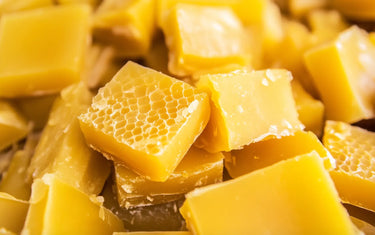5 min read / 22 February 2022 / Laura Garvin Gomez
Commonly Confused Essential Oils - Which is Which?
Ever wondered what separates two similarly named oils? You're not alone.
Share this post

Sometimes understanding the difference between essential oils can be confusing.
From bay laurel and bay leaf to aniseed and star anise, some oils are so similar in name that it seems that they must be interchangeable. In actual fact, many of these similarly named oils have important distinctions that it’s important to be aware of in order to use them correctly.
We know that separating these oils can be difficult, and so we’ve gathered some of the most commonly confused oils in order to clearly lay out their differences. Read on to find out what these oils do and don’t have in common.
What's the difference between Aniseed oil and Star anise oil?
Aniseed essential oil and star anise oil are highly similar in scent, which leads to many people treating them as the same oil. In reality, despite the resemblance in scent, these two oils are distilled from completely separate plants.
The anise plant is native to Egypt, whereas the star anise plant is native to China, and they are so dissimilar in properties that aniseed oil is actually a closer relation to carrots or celery! Both of these oils are also sometimes confused with fennel seed oil due to the liquorice scent that they all share.
What's the difference between Cinnamon bark oil and Cassia oil?
Cinnamon bark oil and cassia oil aren’t exactly the same oil, but they are very close cousins. Both are members of the cinnamon family, and they’re highly similar in both scent and properties. However, cassia is said to have a more bitter scent and a higher potency.

What's the difference between Bay laurel oil and Bay leaf oil?
This is a confusing one. Bay laurel oil, or Laurus nobilis, is extracted from the Mediterranean bay laurel tree. It has different properties from bay leaf oil and differs in scent. Despite this, bay laurel oil is sometimes also referred to as bay leaf oil, which means that these two separate oils sometimes have the same name.
The oil more commonly known as bay leaf oil is Pimenta racemose, extracted from the West Indies bay tree. This oil is also sometimes known as bay rum oil or West Indies bay oil. Still with us? The two oils have some similarities but are still distinctly different in scent and benefits.
What's the difference between Eucalyptus oil and Citriodora oil?
Citriodora oil comes from the lemon eucalyptus tree, which is a subspecies of eucalyptus. Its scent is a cross between that of eucalyptus and citronella and it shares benefits with both.
Eucalyptus oil has a more prominent fresh scent and is more widely known for its decongestant benefits.
What's the difference between Clove bud oil and Clove leaf oil?
As we would expect, clove bud oil is extracted from the buds of the clove plant and clove leaf oil from the leaves. The two oils are very similar in benefits, but clove bud oil is more potent, with a stronger scent and higher levels of eugenol. Clove leaf oil is milder and safer for topical use.

What's the difference between Neroli oil and Petitgrain oil?
Neroli oil and petitgrain oil are both extracted from different parts of the orange tree – neroli is extracted from the blossoms and petitgrain from the leaves and twigs. Despite their proximity, they have different scents and properties.
What's the difference between Geranium oil and Rose geranium oil?
Rose geranium oil comes from a variation of the geranium plant with a strong rosier scent, whereas geranium oil has a slightly more subtle scent. The two oils have fairly identical properties and only really differ in smell.
What's the difference between Citronella oil and Lemongrass oil?
Both citronella oil and lemongrass oil have similar scents and similar insect-repelling abilities. However, they are extracted from two different plants and have different properties.

What's the difference between Mandarin oil and Tangerine oil?
Tangerine oil is a version of the mandarin that evolved after the mandarin was brought from China to the west. The oils have similar benefits and a similar scent but with some subtle differences between the two. Tangerine oil is often considered more potent than mandarin oil.
What's the difference between Black pepper oil and Pink pepper oil?
There are some similarities shared here but these are still two distinctly different oils. Black pepper oil is distilled from the dried peppercorn fruits of a flowering vine native to India. Pink pepper oil is extracted from the ripe fruits of an evergreen Peruvian tree. Whilst they both have a warm spicy scent, pink pepper’s is sweeter and more fruity, and the two have different benefits.
What's the difference between Peppermint oil and Spearmint oil?
Peppermint oil and spearmint oil share many of the same benefits. The only real difference between the two is that spearmint has a sweeter scent and slightly more relaxing than stimulating and energy boosting peppermint.

What's the difference between Carrot oil and Carrot seed oil?
The confusion between these two oils is slightly different, as carrot oil is not an essential oil but a vegetable carrier oil. It therefore has completely separate uses from carrot seed oil, which is a potent essential oil with a range of natural benefits for the skin and hair.
What's the difference between Sage oil and Clary sage oil?
Sage oil and clary sage oil come from the same family of herbs. These two commonly confused oils couldn't be more different from one another, both in terms of benefits and smell profiles.
Clary sage has a delicate and intoxicating floral scent, often being used for calming and relaxing, whereas sage, with a strong herbal aroma carries antibacterial and antifungal properties.
What's the difference between Marjoram oil and Oregano oil?
Oregano is sometimes known as ‘wild marjoram’, leading to the confusion between marjoram oil and oregano oil.
Oregano and marjoram are however completely different herbs offering their own unique scents and benefits.
Oregano with a potent herbal aroma is widely used for it's powerful antibacterial effects. In comparison marjoram is a gentle oil that is often used to soothe aches and pains.

Still not sure how to tell a pair of oils apart? Feel free to contact us at support@nikura.com to ask us any questions you have and we’d be happy to help!









